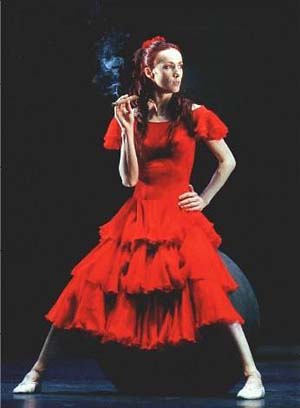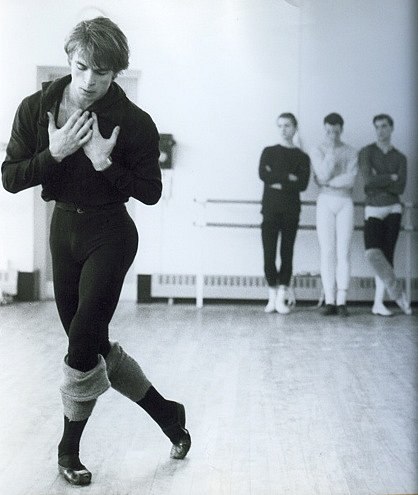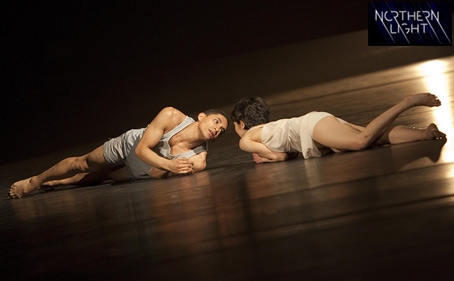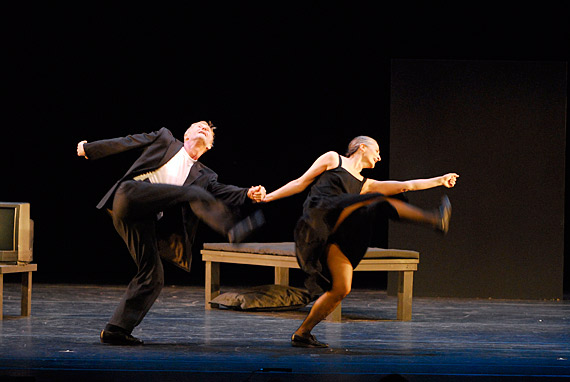At a glittery gala awards ceremony in the beautiful Italian town of Positano on the Amalfi Coast, the legendary Ana Laguna and Mats Ek were awarded the Lifetime Achievement Award as part of the 42nd Positano Leonide Massine dance prize.
Spanish dancer Ana Laguna and Swedish choreographer Mats Ek share an iconic and powerful partnership not only in life, as husband and wife, but also as a creative artistic force. This partnership, their lifetime dialogue and collaboration, changed the landscape of ballet in the late twentieth century.
Ana Laguna spoke exclusively with The Wonderful World of Dance about the Lifetime Achievement Award which was presented to her by Carla Fracci, Italy’s revered prima ballerina, “it’s wonderful, a great honour to receive such a prize. It means also you have a lot of memories of someone who has so much to do with contemporary dance and Mats he is a very contemporary choreographer too.”

Ana & Mats
Ana Laguna’s long and distinguished career began when she joined the Cullberg Ballet in Sweden at the age of 18, having a breakthrough moment in Mats Ek production of St George and the Dragon (1976). It was this meeting at the Cullberg Ballet that blossomed into a lifetime of collaboration, Ana explains, “I worked with Mats before we even developed privately. That is something which people mistake because they think that we worked together because we are together.’”
Ana and Mats have worked separately on creative projects and established themselves independently before coming together. And it is this history and their established process for working together that’s so important to their creative work and their relationship.
Creating Giselle
One of Mats Ek’s pivotal works is Giselle which he famously created on Ana as his muse. It is easy to imagine that a choreographer discovers their muse, feels inspired and simply creates ballets, roles or pieces for that dancer – that the dancer is inspiration only and removed from the process. But it is the coming together in the exploration of the emotions, the history and the interpretation of a role or ballet that breathes life into a new creation. A journey together, dancer and choreographer, Ana shares her experience of working with Mats on Giselle, “The part was created for me, but it was created together with me. I was there at that moment and if it had been somebody else, he would have created another kind of Giselle.
“When we did Giselle, we went into who Giselle is and I tried to go into what Giselle felt and what [Mats] wanted to do with Giselle. I tried to understand Giselle, what she thought and when we talked about it, who is Giselle and how in that moment she reacts. In that case she wasn’t me. She comes through me and also because it was me.”
Career highlights
Ana’s illustrious career has seen her dance around the world and with the ballet greats. When I asked Ana to select some career highlights she said she found it difficult to select just one or two moments from a career that includes dancing with Rudolf Nureyev and Mikhail Baryshnikov, “I think there are so many highlights for me, all of them I could say are highlights. I have had the chance through my years of dancing to work with some wonderful creators. I think the moments are so much in relation to what you do at that time.”
Preparing for roles
Ana has been celebrated for her sensitivity to her roles, her interpretation and her technique and musicality. Ana has always thoroughly prepared and researched the roles she is gifted to dance, “I think we have to do the research. If you play Juliet in a ballet and you dance Juliet and you’ve never read anything about Juliet in Shakespeare, how can you present Juliet as she is? How can you put yourself in the situation as Juliet if you don’t know who Juliet is? So, of course, you need to research.
“With Juliet – you are Juliet in that place, so the stage is your village square, it’s your balcony, the room where you sleep or your nanny. If you make that place yours, the audience will be able to come into your world and understand that. If you’re trying to convince the audience to ‘Here, look, now I am on the square. Now I am on the balcony’ then somehow the audience doesn’t really believe.”
Ana continues discussing her role as Carmen, “It is not enough to only take Carmen from the opera. With all the research you have to go down into the soul [of the characters]. To find who these people are and only in that way you can go into that person’s situation. I believe I have to go into that person’s situation rather than that person coming into me.

Being Ana
Surprisingly Ana never likes to be ‘Ana’ on stage, “I try to escape or try to avoid being Ana. I really need to go into the character’s situation rather than showing myself because then I show myself how personally I see Juliet should be done rather than trying to put myself into Juliet’s situation – because I will never answer Romeo in that way because I’m not Juliet – she answers to Romeo in a way because she is that way. The positive of being oneself on stage is as a dancer, or actor, that you step onto a stage you’re completely naked and you can never involve yourself but at the same time you can go into the role, you have to go in in the person’s situation. That’s what I would call the interpretation.”
When Ana speaks about preparing for a role, she does so with passion, with a sense humbleness and respect for the history and responsibility she has to the role, “It is without any pretension to go into the depth of our feelings, our problems or our happiness, and that’s what I would say is more important rather than pretending to be someone.
“We have to be humble and explore. When we dance we learn – every time we go into the studio and confront yourself with the choreographer, you have to expose yourself. Also, the choreographer usually does that. You put yourself up for the first time, like it’s the first day in school, like if you don’t know anything. You have to be open to give but also open to receive.”
Dancing with Nureyev
Ana famously danced Juliet with Rudolf Nureyev, who’s home for the last 25 years of his life is a small island called Li Galli just in front of Positano. I cannot help but ask Ana about her experience of dancing with Nureyev, “we had a great time I must say. I danced Juliet with him – he came from another company and some people used to say that he was very unpleasant, so we were warned about that. But he was not unpleasant at all. On the stage he was wonderful too, so I did not see any unpleasant side. Of course I could see the complexities but that goes together with the complete artist. That’s the complexity of the person. We are full of so many different sides, so to deny one side or the other is not fair. But he was wonderful with us. He was wonderful with me. We had a great time on stage and I enjoyed it very much. I hope he did too. It seemed like it when we talked about it when we were on the stage, so I have good memories. And also outside the stage we talked about very deep things and worrying things. My memories with him are wonderful.”

Dance experience
As a dancer, choreographic assistant and through her vast dance projects Ana has worked with a wide range of dancers from various companies and countries such as Nederlands Dans Theater and Spanish National Dance Company, an experience that she finds enriching and positive, “there are only positive things about that, even if it’s a controversial situation sometimes, you only get richer by experiences.”
Ana’s experiences include theatre and TV appearances and I asked Ana to explain the difference between performing on stage with an audience and performing for TV, “usually what we perform on TV has been performed on stage already. So you have a base, a relation to the piece and the situation of the person you play or the person you dance – but it is a little different if it is made directly for television at that moment.
“I have performed many times for TV and I would say it’s much more difficult because you have only that chance. You don’t have two or three chances like you have on stage. On stage you also have only that chance, of course, but you have another and another [the next nights]. Also on TV you have no response from an audience.”
Ana explains that the reaction of the audience is important, that their feelings are challenged or changed and it is also good “if one gets very upset also, not only to be entertained by being happy. And if they don’t like it, ‘why didn’t you like it?’ Maybe there is question for oneself and then you start to think about it and you rediscover things and feelings.”
Creating new works
Ana is a dancer, artist, choreographer, creator, and she is not one to hang up her ballet shoes. Ana and Mats continue to work together, pushing boundaries and challenging themselves and their art-form. Currently, they are preparing to perform at London’s Sadler’s Wells theatre for the Elixir Festival, “we are working at this age but I think that if there’s a possibility for a dancer who comes to a certain age to continue, I think they should continue. It’s good to be able to do that as long as the person wants to continue, as long as the person can continue. It’s not always the case either. It depends also on the limitations of your own body – I would say dance as long as you accept in a certain age those limitations. But if one uses, in a way, or if one accepts that limitation, I think that limitation opens up new possibilities which are very different than the new possibilities for young people, but they’re just different and why not? It’s like life. It’s part of life.”

Ana’s advice
The dance world is fortunate that Ana continues to give, to share her experience and to pass on and to create new works, “in a different way, of course, than the young people can and that’s what is good because it gives that diversity of a human being, what we all have in different places of our life.
“Sometimes I work with young people. I say, ‘Oh, wow, you can do anything’, it’s nice to try to take them where maybe didn’t go yourself or you see they can go even further. I would not say physically only, but also emotionally, combining their feelings with their technique.
Ana’s insightfulness into the world of dance is captivating and her wise words should be headed, “As Pina Bausch said – dance, dance, otherwise we are lost – I think dance is really important and should be taken care of by society – it is also good for the soul.”
And what advice does the legendary Ana Laguna have for today’s aspiring dancers, “if you feel it, you should dance. If they really believe that’s the way they want to express themselves, go ahead. Sometimes I think people often see dancers for how hard they work and how difficult it is and how much you have to sacrifice, but very seldom do they talk about the satisfaction that dance gives you. And there’s so much satisfaction they can give too. I think one should also think about the possibilities. And psychologically it’s a great thing to dance.
Ana continues, “when you work with a role for example, when you go into those people, their feelings and their situations, relations, and mentally, psychologically you work hard and you involve yourself which is healthy.”
And finally, Ana imparts another pearl of wisdom, and I paraphrase here because I cannot translate perfectly her Spanish intention when she says, “It’s not easy. Some people don’t dare to go there with a role because it is painful, but it is necessary. It all starts with a feeling. What is felt is made, it is the feeling of the one who makes it, dancing it, an idea, because of one’s soul and of one’s feeling. If there’s no feeling when you dance, you’re just an instrument which is uninteresting, no matter which age you are.”
Coming to London
Mats Ek and Ana Laguna continue their legacy, challenging and inspiring today’s audience with their upcoming piece at Sadler’s Wells, KnowBody; A lifetime of experiences (12-15 September) which presents a mixed programme of work that will enthral audiences.

I’m left in deep thought from my discussion with Ana and no doubt the audience will be moved by their upcoming work at Sadler’s Wells. I will cherish my time speaking with Ana Laguna, I feel I have been privileged to gain a small glimpse into a deeply thoughtful, intelligent and inspiring mind of a legendary dancer.
For more information about Ana Laguna and Mats Ek’s production, click here: Sadler’s Wells.
Ana is Spanish and lives in Sweden and the interview was conducted in English, so I hope that I have done justice to her inspiring words and conveyed their meaning appropriately.
For more information about the 42nd Positano Leonide Massine dance prize, click here.


